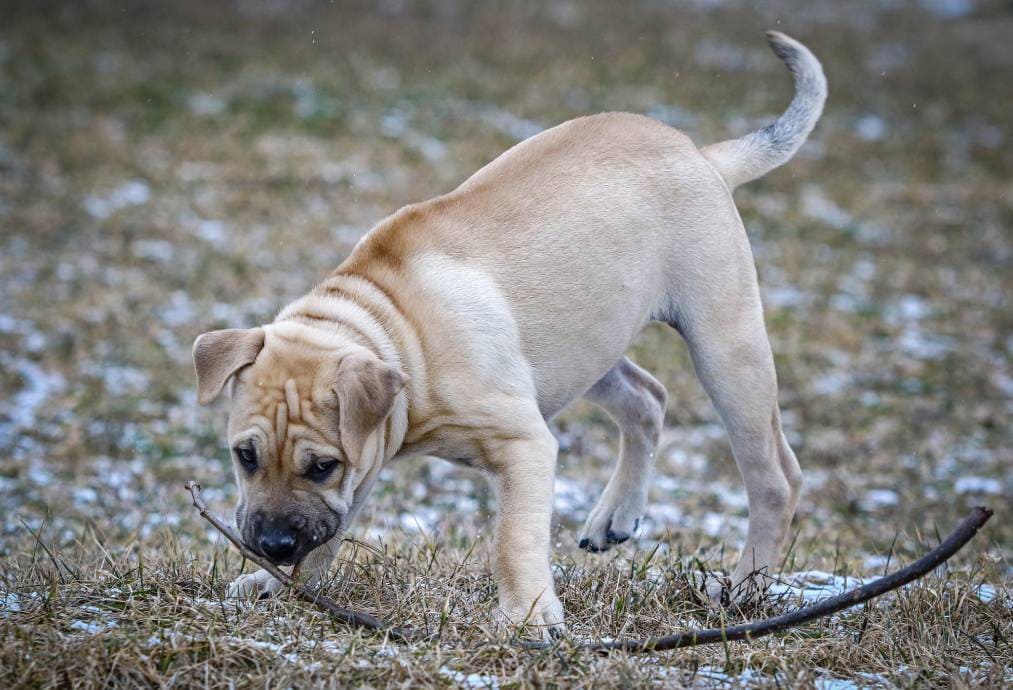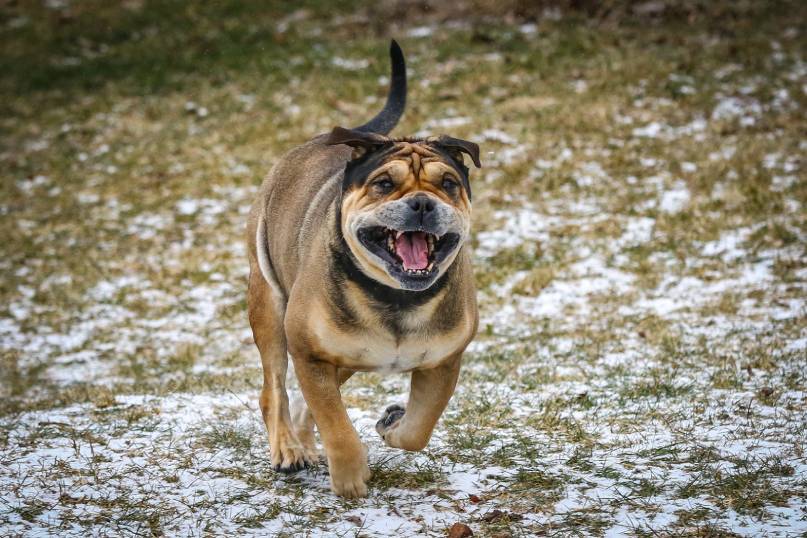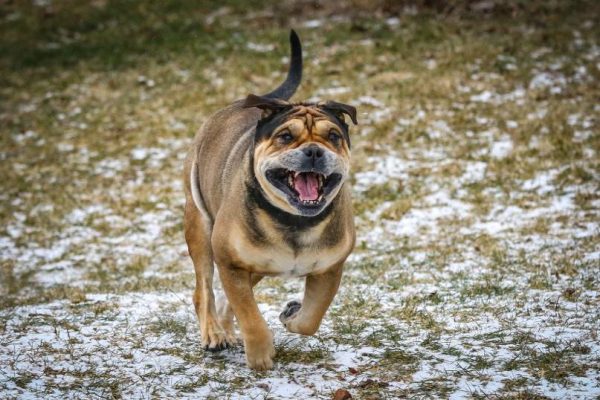Click Below to Skip Ahead
The Majorca Mastiff is known by many names, including Ca de Bou, Majorcan Bulldog, and Presa Canario Mallorquin. This powerful dog was bred as a guard dog, bull dog, and hunting dog for powerful, dangerous game. They are a quiet breed, but that doesn’t mean they’re timid. This breed is known for its loyalty and devotion to its master, its bravery, courage, and overall good-natured demeanor with people it knows.
Breed Overview
Height:
20.5 – 23 inches
Weight:
66 – 84 pounds
Lifespan:
10 – 12 years
Colors:
Brindle, fawn, black
Suitable for:
Use as guard dogs, active families and singles, experienced dog owners, hunting large game
Temperament:
Loyal and devoted, brave, quiet
This breed has been around for potentially hundreds of years, but they weren’t added to the stud book in their native Spain until 1923. They began being shown in 1929, and they were accepted as a UKC recognized breed in 2006. The Majorca Mastiff is not a recognized breed in the AKC, but this is likely due to its rarity in the United States.
 Majorca Mastiff Puppies
Majorca Mastiff Puppies
This is a rare breed in the United States, so even finding a Majorca Mastiff puppy may be next to impossible. It’s likely you’ll have to import a puppy, which can be a costly investment.
These loyal and devoted pups will be a wonderful addition to your family a a pet and you can expect them to be a good watch dog as well. It should be noted that they are better suited to more experienced dog owners.
Temperament & Intelligence of the Majorca Mastiff
Are These Dogs Good for Families?
Due to their protective, loyal nature, the Majorca Mastiff can be a fantastic dog for families. They tend to be patient and tolerant, making them a good fit with children. However, they need to be properly socialized, trained, and taught appropriate boundaries to have the best chance at getting along with children. The large size and powerful body and jaws of this breed means that it can easily harm a child, even just through rough play. Like with all dogs, Majorca Mastiffs and children should always be supervised when together.
Although they are great guard dogs, they are typically good with people if they have been properly socialized. This means that they are usually tolerant of visitors to the home who have been properly introduced. They may be friendly toward people outside of their own household, but they are more likely to be indifferent or quiet.
Does This Breed Get Along with Other Pets?
When it comes to other animals, the Majorca Mastiff can be hit or miss. Proper socialization, training, and introductions are an absolute must for the best chance of a Majorca Mastiff having a good relationship with other animals. They are at an elevated risk of injuring small animals, if even by accident, due to their size. Their background as bull dogs and fighting dogs means they may have some genetic predispositions to animal aggression and reactivity. These tendencies need to be addressed early to provide the best opportunity to the dog to improve its interactions with other animals.
 Things to Know When Owning a Majorca Mastiff:
Things to Know When Owning a Majorca Mastiff:
Food & Diet Requirements
Due to their large size, you’re likely to feed an adult Majorca Mastiff between 4 – 6 cups of food per day. How much you feed is dependent on the quality of the food and the activity level of the dog. They are at the same risk for obesity as most other mastiff breeds. Extra weight puts additional strain on the joints and spine, which are already at considerable risk for large and giant breed dogs. Aim to feed your dog the correct amount of food to maintain a healthy weight, making adjustments as needed. Your dog’s veterinarian is an excellent resource when it comes to helping you understand the nutritional needs of your large breed dog. They can provide guidance on the type of food and portion sizes you are providing.
Exercise
Although relatively laid-back, these dogs do need daily activity. They are not a good fit for low activity homes. Ideally, your dog should get at least 1 hour of exercise daily. This can be walking, running, or sports. On top of that, an additional 30 minutes or longer of playtime will help burn excess energy and build a stronger bond between you and your dog. Toys and games that engage your dog, like flirt poles and tug toys, are a great way to not only keep your dog active but also to engage some of its instincts that have carefully been bred into the breed for hundreds of years.
Training
This is not the most trainable dog breed, so they are best taken on by experienced dog owners who know how to properly train a large dog. A poorly trained Majorca Mastiff can quickly become a problem because they are so strong. Balanced training is ideal for this breed, and a variety of training tools and approaches may be appropriate. The loyal nature of this breed means that they aim to please their owner, which can make some aspects of training a little bit easier. Patience is key when it comes to training. It may take time, effort, and lots of treats, but training a Majorca Mastiff is absolutely possible with the right guidance.

Grooming ✂️
The Majorca Mastiff has minimal grooming needs. Once weekly brushing and routine bathing will usually be enough to keep the coat and skin healthy. Dogs with skin folds may require more frequent bathing or skin care. If you’re unsure of whether your dog’s skin or coat condition is normal, your dog’s veterinarian is a great resource to ensure you aren’t dealing with infections or allergies. Nail trims should be performed as needed.
Health and Conditions
- Skin Infections
- Skin Allergies
- Arthritis
- Urinary Tract Infections
- Cherry Eye
- Cataracts
- Bloat
- Hip Dysplasia
- Elbow Dysplasia
- Progressive Retinal Atrophy
- Osteosarcoma
- Lymphosarcoma
- Cardiomyopathy
- Epilepsy
Male vs Female
Male Majorca Mastiffs are often visually different from females, sporting a broader skull and snout, and a boxier skull shape. Temperament-wise, there are few differences known between males and females of this breed. Male dogs in general are more likely to be laid-back and friendly, while females are often more protective and less accepting of other people and animals outside of their own family.
3 Little-Known Facts About the Majorca Mastiff
1. They were used in bull fighting
This breed is powerful and fearless, making them ideal for traditional bull fighting and managing and handling bulls as livestock. In Spain, the Majorca Mastiff is most commonly known as the Ca de Bou, which means bull dog.
2. They nearly went extinct
In the early 20th century, there were multiple changes that impacted the number of Majorca Mastiffs being bred. The First and second world wars, as well as economic downturns, all impacted dog ownership and breeding. Many people simply couldn’t afford a dog and puppies. In the 1940s, Spain outlawed dog fighting, which further negatively impacted the breed. As other breeds rose to popularity, the Majorca Mastiff nearly went extinct. Thanks to concerted efforts in breeding programs, they do still exist, but they are a rare breed in most parts of the world.
3. There may not be any true Majorca Mastiffs today
Due to the dangerously low numbers the breed experienced, it went functionally extinct. To create the current dogs we see today, some other dogs may have been crossed into the breed to create genetic diversity and prevent inbreeding. This would have primarily occurred between the 1980s and today, but it is unclear if there is any DNA left in today’s dogs from the dogs of the early 20th century.
 Conclusion
Conclusion
The Majorca Mastiff is a beautiful breed of dog that has faced many hardships. Thankfully, breeding programs are continuing to attempt to add numbers to the breed and raise awareness and popularity of the breed. They are not for the beginning dog owner, though, and should only be taken on by someone who is knowledgeable about mastiffs in general, as well as dog training and socialization. A poorly trained or socialized Majorca Mastiff can be quite a handful. In the right hands, though, the Majorca Mastiff is a loyal, courageous companion that won’t bark your ear off, but will happily go on adventures with you.
See also:
- Mountain Mastiff (Bernese Mountain Dog & Mastiff Mix)
- 9 Best Dog Foods for Mastiffs – Reviews & Top Picks
- Mastador (Bullmastiff and Labrador Retriever Mix)
Featured Image Credit: Katatonia82, Shutterstock



 Majorca Mastiff Puppies
Majorca Mastiff Puppies Things to Know When Owning a Majorca Mastiff:
Things to Know When Owning a Majorca Mastiff: Conclusion
Conclusion



